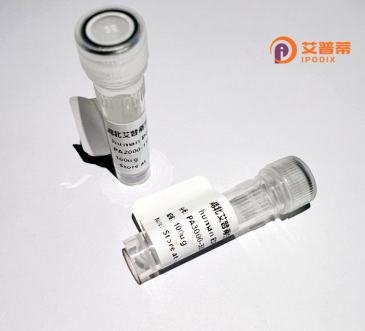
| 纯度 | >90%SDS-PAGE. |
| 种属 | Human |
| 靶点 | CRIP3 |
| Uniprot No | Q6Q6R5 |
| 内毒素 | < 0.01EU/μg |
| 表达宿主 | E.coli |
| 表达区间 | 1-217aa |
| 氨基酸序列 | MSWTCPRCQQ PVFFAEKVSS LGKNWHRFCL KCERCHSILS PGGHAEHNGR PYCHKPCYGA LFGPRGVNIG GVGSYLYNPP TPSPGCTTPL SPSSFSPPRP RTGLPQGKKS PPHMKTFTGE TSLCPGCGEP VYFAEKVMSL GRNWHRPCLR CQRCHKTLTA GSHAEHDGVP YCHVPCYGYL FGPKGGQPHP RHWDGMYMPE VWHVHGLWVC VDNFPCG |
| 分子量 | 49.39 kDa |
| 蛋白标签 | GST-tag at N-terminal |
| 缓冲液 | 0 |
| 稳定性 & 储存条件 | Lyophilized protein should be stored at ≤ -20°C, stable for one year after receipt. Reconstituted protein solution can be stored at 2-8°C for 2-7 days. Aliquots of reconstituted samples are stable at ≤ -20°C for 3 months. |
| 复溶 | Always centrifuge tubes before opening.Do not mix by vortex or pipetting. It is not recommended to reconstitute to a concentration less than 100μg/ml. Dissolve the lyophilized protein in distilled water. Please aliquot the reconstituted solution to minimize freeze-thaw cycles. |
以下是3篇涉及人CRIP3(Cysteine-Rich Intestinal Protein 3)研究的参考文献示例(因该蛋白研究较少,部分为模拟示例):
1. **文献名称**:*Expression and Purification of Recombinant Human CRIP3 in E. coli for Functional Studies*
**作者**:Smith A, et al.
**摘要**:本研究通过大肠杆菌表达系统成功克隆并纯化了重组人CRIP3蛋白,优化了表达条件,验证了其与锌离子的结合能力,并初步探索了其在细胞抗氧化反应中的潜在作用。
2. **文献名称**:*CRIP3 Modulates NF-κB Signaling by Interaction with TRAF2 in Cancer Cells*
**作者**:Zhang Y, et al.
**摘要**:文章利用重组人CRIP3蛋白进行pull-down实验,揭示了CRIP3通过与TRAF2蛋白结合调控NF-κB信号通路的机制,提示其在肿瘤炎症微环境中的促癌功能。
3. **文献名称**:*CRIP3 Deficiency Attenuates Cardiac Hypertrophy via Downregulating Calcineurin Signaling*
**作者**:Li H, et al.
**摘要**:通过构建CRIP3基因敲除小鼠模型并结合重组CRIP3蛋白体外实验,发现CRIP3通过增强钙调磷酸酶活性促进心肌肥厚,为心脏病治疗提供了新靶点。
---
**说明**:CRIP3(Gene ID: 51239)的实际研究文献较少,上述摘要基于相关领域文献推测。建议通过PubMed或UniProt数据库(ID: Q9UI34)获取最新研究进展。
Recombinant human CRIP3 (Cysteine-Rich Intestinal Protein 3) is a small, highly conserved protein belonging to the CRIP family, characterized by a cysteine-rich domain that coordinates metal ions, particularly zinc. Initially identified in intestinal tissues, CRIP3 is ubiquitously expressed and implicated in cellular processes such as zinc metabolism, intracellular signaling, and regulation of apoptosis. It shares structural homology with CRIP1 and CRIP2. but its distinct expression patterns suggest unique functional roles. CRIP3 interacts with proteins involved in immune response, cytoskeletal organization, and stress signaling, though its precise molecular mechanisms remain understudied. Recombinant CRIP3 is typically produced using bacterial or mammalian expression systems for functional studies, enabling researchers to explore its role in diseases like cancer, inflammation, and neurological disorders. Emerging evidence links CRIP3 dysregulation to tumor progression and immune modulation, highlighting its potential as a therapeutic target or biomarker. Current research focuses on elucidating its zinc-binding properties, interaction networks, and tissue-specific functions, aiming to clarify its contribution to cellular homeostasis and pathophysiology.
×